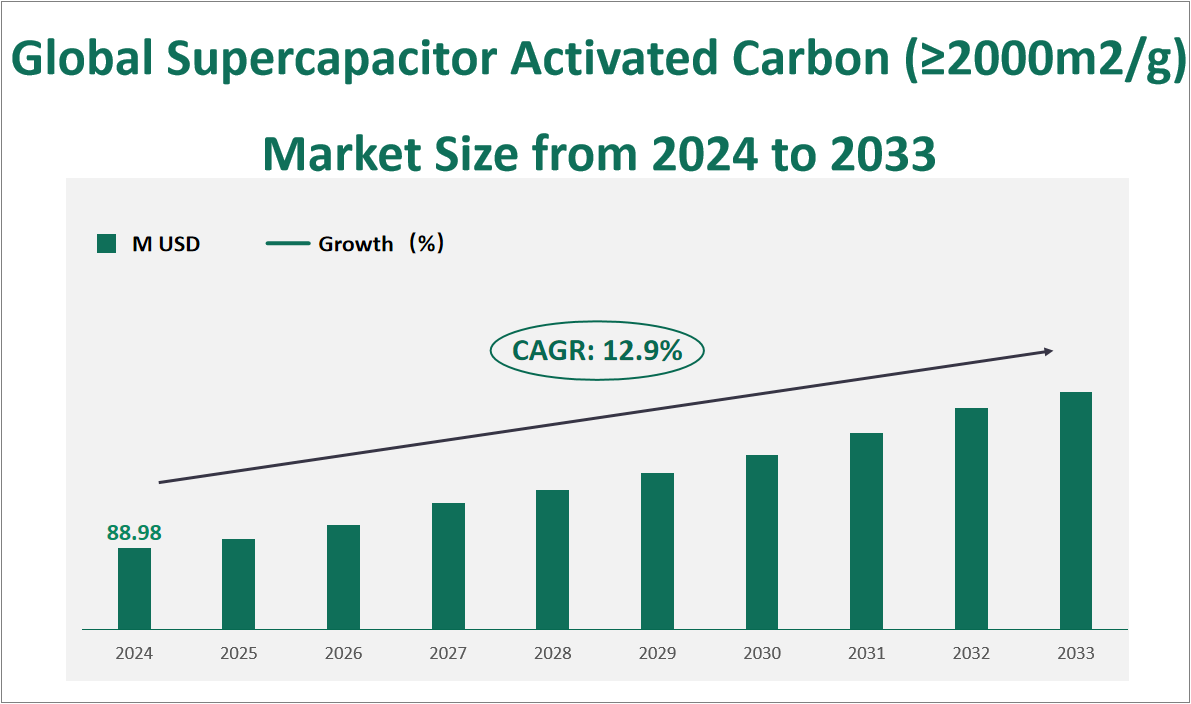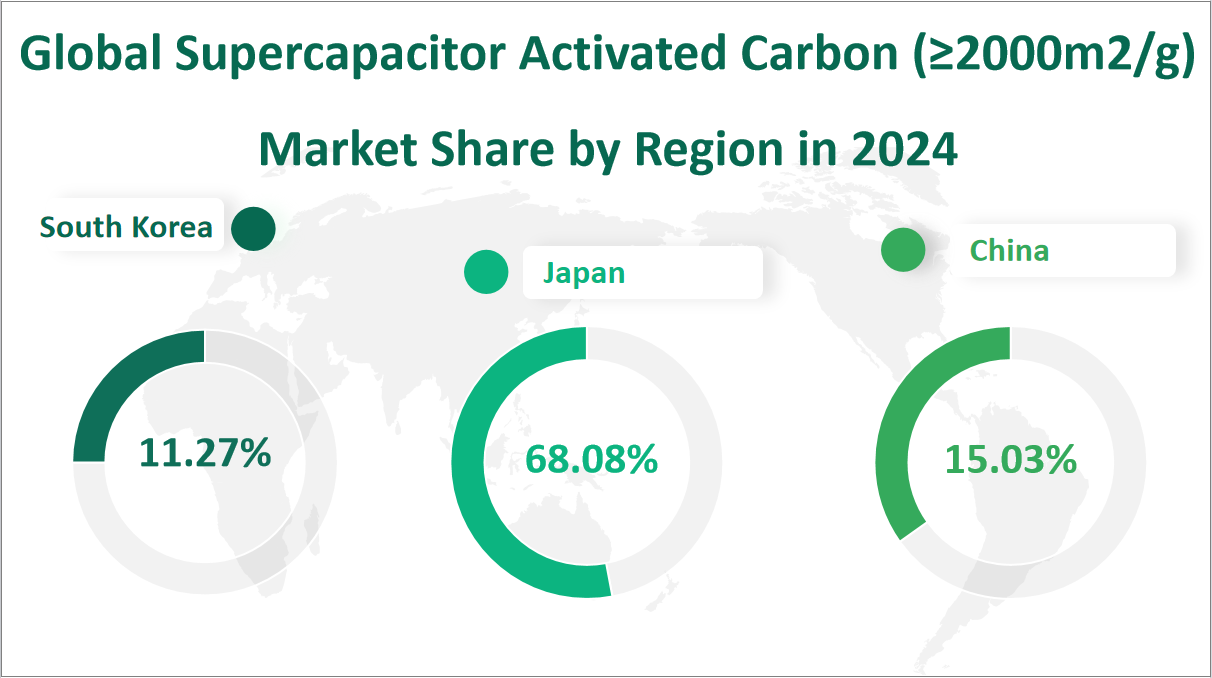1 Global Supercapacitor Activated Carbon (≥2000m2/g) Market Outlook
The global Supercapacitor Activated Carbon (≥2000m2/g) market is projected to exhibit substantial growth in the coming years, with a CAGR of 12.9% from 2024 to 2033, reaching a total market size of $88.98 million USD in 2024. Supercapacitors are electrochemical energy storage systems designed to store and transfer energy quickly. Supercapacitor Activated Carbon (≥2000m2/g) is mainly used in supercapacitors, and is purified to reduce ash below 1% and to reduce halogen and iron impurities below 100 ppm to enable extended cycling. It has the characteristics of a large specific surface area, good electrochemical performance, and high capacity.
Figure Global Supercapacitor Activated Carbon (≥2000m2/g) Market Size and Growth Rate (2024-2033)

2 Supercapacitor Activated Carbon (≥2000m2/g) Market Growth Drivers and Constraints
The growth of the supercapacitor activated carbon market is primarily driven by the advantages of supercapacitor activated carbon itself, which includes its large energy storage capacity, high power density, rapid charge/discharge capabilities, and excellent cycle stability. These characteristics position supercapacitors as a new type of energy storage device that can offer advanced power density compared to batteries and higher energy density than traditional capacitors. The increasing demand for renewable energy systems and the promotion of favorable government regulations have led to wider use of supercapacitors in solar and wind power, solar photovoltaic panels, and solar lighting, indicating new directions for the future development of supercapacitors. However, the market is also facing certain restraints. One of the main challenges is the relatively low specific energy of supercapacitors, which means they store much lower energy per unit weight compared to electrochemical batteries like lithium-ion batteries. Additionally, supercapacitors are not suitable for long-term energy storage due to their high self-discharge rates and the need for voltage balancing elements when connected in series, which makes it difficult to produce supercapacitors with high voltage capacity. The higher price of supercapacitors compared to lithium-ion batteries of the same capacity also contributes to their limited market share and hinders the development of the supercapacitor activated carbon industry.
3 Supercapacitor Activated Carbon (≥2000m2/g) Market Innovations and M&A Activities
The reactivation carbon production facilities of Calgon Carbon’s Belgium subsidiary, which commenced operations in October 2022. Kuraray, which acquired Calgon Carbon in 2018, announced the expansion and full-scale operation of these facilities at its Feluy Plant. This development is expected to enhance Calgon Carbon’s ability to provide a stable global supply of activated carbon and contribute to environmental solutions. Additionally, Haycarb PLC, celebrating 50 years in the industry, is expanding its capacity and presence in emerging markets, high-end applications, and specialized segments. The company is investing in R&D and manufacturing capacity for supercapacitors, which are used in various applications such as wind turbines, transportation systems, and automotive engines. Haycarb is also developing hard carbon for sodium-ion batteries, an alternative to lithium-ion batteries, further diversifying its product portfolio and capitalizing on the growing demand for alternative energy storage solutions.
4 Global Supercapacitor Activated Carbon (≥2000m2/g) Market Analysis by Type
In 2024, the global supercapacitor activated carbon market, categorized by type, is projected to demonstrate significant growth in both production value and market share. For the 2000-2200 m²/g type, the production value is forecasted to reach 45.74 million USD, showcasing a substantial increase from previous years. This type is expected to capture a market share of 51.41%, indicating a dominant position in the supercapacitor activated carbon market. On the other hand, the production value for the above 2200 m²/g type is estimated at 43.23 million USD, with a market share of 48.59%, slightly lower than the 2000-2200 m²/g type but still a significant portion of the overall market. These figures for 2024 underscore the competitive landscape within the supercapacitor activated carbon industry, where both types continue to hold substantial market value and share, reflecting the diverse demands and applications in the energy storage sector.
Table Global Supercapacitor Activated Carbon (≥2000m2/g) Market Size and Share by Type in 2024
Type | Market Size in 2024 (M USD) | Market Share in 2024 (%) |
|---|---|---|
2000-2200 m2/g | 45.74 | 51.41% |
Above 2200 m2/g | 43.23 | 48.59% |
5 Global Supercapacitor Activated Carbon (≥2000m2/g) Market Analysis by Application
In 2024, the global supercapacitor activated carbon market, when analyzed by application, exhibits a notable distribution in production value and market share. For Electric Double-layer Capacitors (EDLCs), the production value is anticipated to be 81.67 million USD, which accounts for a significant 91.78% of the total market share, reflecting the predominant role of EDLCs in the application of supercapacitor activated carbon. Conversely, Lithium-ion Capacitors (LICs) are projected to have a production value of 7.31 million USD, capturing 8.22% of the market share. These figures for 2024 highlight the substantial contribution of EDLCs to the supercapacitor activated carbon market, while also indicating the growing importance of LICs within the energy storage applications sector. The production values and market shares underscore the evolving dynamics within the supercapacitor industry, where EDLCs maintain a leading position, and LICs are emerging as a significant application area.
Table Global Supercapacitor Activated Carbon (≥2000m2/g) Market Size and Share by Application in 2024
Application | Market Size in 2024 (M USD) | Market Share in 2024 (%) |
|---|---|---|
Electric Double-layer Capacitors (EDLCs) | 81.67 | 91.78% |
Lithium-ion Capacitors (LICs) | 7.31 | 8.22% |
6 Global Supercapacitor Activated Carbon (≥2000m2/g) Market Analysis by Region
In 2024, the global supercapacitor activated carbon market exhibits a distinct distribution in production value and market share among key regions, with Japan, China, and South Korea playing significant roles. Japan leads with an expected production value of 60.57 million USD, maintaining its strong presence in the market with a share of 68.08%. China follows with a projected production value of 13.37 million USD, contributing to a 15.03% market share, indicating a growing impact in the industry. South Korea also shows a notable production value of 10.03 million USD, securing an 11.27% market share. These figures for 2024 underscore the regional dynamics within the supercapacitor activated carbon market, highlighting the continued dominance of Japan, the emerging influence of China, and the steady contribution of South Korea to the global supply chain.
Figure Global Supercapacitor Activated Carbon (≥2000m2/g) Market Share by Region in 2024

7 Top 3 Companies of Global Supercapacitor Activated Carbon (≥2000m2/g) Market
7.1 Kuraray
Company Introduction and Business Overview:
KURARAY CHEMICAL CO., LTD., as the predecessor of KURARAY CO., LTD. Environmental Solutions Division, began with the production and sales of carbon disulfide. The activated carbon business began in 1965 and the company gradually shifted to the activated carbon business. When the production of carbon disulfide stopped in 1987, Kuraray’s business specialized in activated carbon business, functional activated carbon business, and equipment manufacturing business placing the activated carbon technology as the core of the company.
Products Offered:
Kuraray, a company with a long history dating back to 1926, specializes in the production of functional activated carbon for various applications, including electric double-layer capacitors (EDLCs). Their product portfolio encompasses granular, powdered, pellet, filter, and fiber forms of activated carbon. Kuraray initiated the production of activated carbon fiber (ACF) in 1980 and commercialized electric double-layer capacitors using ACF fabrics during the 1980s. They have since expanded their offerings to include fine powder activated carbon (such as YP) to meet the diversifying needs of EDLCs and provide solutions for electrode materials, water purification, deodorization, and other applications. Kuraray’s activated carbon products are characterized by their highly controlled pore structures tailored to specific applications, various forms from granular to micrometer-scale powders, broad adsorption performance due to appropriate activated carbon composition, and unique functions resulting from particular chemical treatments.
Sales Revenue in 2024:
In 2024, Kuraray is projected to achieve a revenue of 51.47 million USD from its supercapacitor activated carbon (≥2000m2/g) production, indicating a continued growth in the company’s financial performance in this specific market segment. This figure represents an upward trend from previous years and underscores Kuraray’s strong position in the global supercapacitor activated carbon industry.
7.2 Power Carbon Technology
Company Introduction and Business Overview:
In the last 10 years, PCT has been dedicated in the development of High Quality Activated Carbon which is applied in EDLC (Electric Double Layer Capacitor), and High Output Soft Carbon which is applied in LIB (Lithium Ion Battery). What’s more, PCT also improved energy storage device’s performances (energy density, output density, life), and found the connection between storage device’s performances and properties of carbon material by introducing new production process.
Products Offered:
Power Carbon Technology offers a range of activated carbon products crafted from raw materials such as cokes and coconut shells, which are known for their large surface area and high-quality surface area ranging from 1,500 to 4,000 m²/g with a uniform pore size distribution. These activated carbons are utilized in applications like catalysts for fuel cells, gas storage, air purification, and energy storage, including electric double layer capacitors (EDLCs) and lithium-ion capacitors (LICs). The company’s activated carbon is distinguished by its uniform particle-size distribution, low metal impurity content, high capacitance, and low resistance, making it ideal for use as an electrode in EDLCs and as a cathode material in LICs.
Sales Revenue in 2024:
For the year 2024, Power Carbon Technology is forecasted to generate a revenue of 7.20 million USD from its supercapacitor activated carbon (≥2000m2/g) production, reflecting a steady increase in the company’s financial performance in this market segment and indicating its sustained growth and market presence within the supercapacitor activated carbon industry.
7.3 Haycarb
Company Introduction and Business Overview:
Haycarb is a Sri Lankan coconut shell based activated carbon manufacturing company. Established in 1973 – the first in any coconut producing nation, Haycarb operates six Activated Carbon manufacturing locations in Sri Lanka, Thailand, and Indonesia, supplying a global sales network with marketing subsidiaries in the USA, UK, and Australia.
Products Offered:
Haycarb’s Supercapacitor Activated Carbon (≥2000m2/g) product portfolio is tailored to meet the demands of the energy storage industry, particularly with their Energy Storage Series. This series is designed for both ultracapacitors and battery applications, offering a high specific surface area due to the extensive pore network, which contributes to the high double-layer capacity for EDLC products. The Haycarb Activated Carbon Energy series is known for its consistent particle size distribution, high purity, and low internal resistance (ESR), ensuring high efficiency, electrode stability, and a longer lifespan with minimal degradation over numerous charge cycles and across various voltage levels and temperatures. Additionally, Haycarb has developed Hard Carbon, a high-quality material for use in Sodium ion and Lithium ion batteries and capacitors, created from coconut shell charcoal and proprietary technology, which excels in energy density, long cycle life, and excellent power performance.
Sales Revenue in 2024:
Haycarb is projected to achieve a revenue of 4.25 million USD from its Supercapacitor Activated Carbon (≥2000m2/g) in 2024, indicating a continuous growth trajectory in the company’s financial performance within the supercapacitor activated carbon market segment . This revenue figure reflects Haycarb’s expanding market presence and its ability to capitalize on the increasing demand for high-quality activated carbon in energy storage applications.

